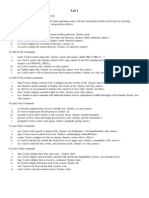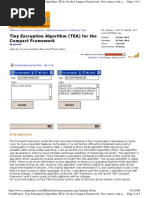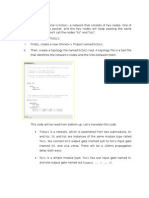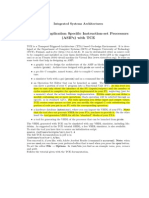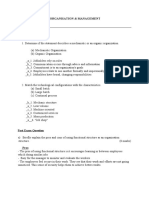0 ratings0% found this document useful (0 votes)
29 views10 Read Netcdf Python
The document discusses how to work with NetCDF files in Python using the netCDF4 module, which provides a simple interface to read and interrogate NetCDF data including dimensions, variables, attributes, and opening NetCDF files with the Dataset() constructor. The netCDF4 module can read any NetCDF format including the classic data model which is made up of dimensions, variables, and attributes that can be interrogated through dictionary calls on the dataset object.
Uploaded by
Eliton FigueiredoCopyright
© © All Rights Reserved
Available Formats
Download as PDF, TXT or read online on Scribd
0 ratings0% found this document useful (0 votes)
29 views10 Read Netcdf Python
The document discusses how to work with NetCDF files in Python using the netCDF4 module, which provides a simple interface to read and interrogate NetCDF data including dimensions, variables, attributes, and opening NetCDF files with the Dataset() constructor. The netCDF4 module can read any NetCDF format including the classic data model which is made up of dimensions, variables, and attributes that can be interrogated through dictionary calls on the dataset object.
Uploaded by
Eliton FigueiredoCopyright
© © All Rights Reserved
Available Formats
Download as PDF, TXT or read online on Scribd
You are on page 1/ 9
Reading NetCDF files with
Python
Thanks to all contributors:
Stephen Pascoe, Jeff Whittaker
So many options!
There are many options for working with NetCDF files
in Python. In this example we have chosen to highlight
the use of the netCDF4-python module.
The netCDF4-python module is useful because:
• It implements the basic “classic” model as well as
more advanced features.
• It provides a simple interface to the NetCDF
structure.
• It has been used as the underlying NetCDF I/O layer
for many more advanced packages.
Opening a netCDF file
To open a netCDF file from python, you simply call the
Dataset() constructor as follows:
>>> from netCDF4 import Dataset
>>> dataset = Dataset('data.nc')
>>> print dataset.file_format
NETCDF4_CLASSIC
Working with “classic” NetCDF
The netCDF4 module can read in any netCDF format.
This tutorial will focus exclusively on the NetCDF-
”classic” data model using: NETCDF4_CLASSIC
The "classic" data model is made up of dimensions,
variables and attributes (as discussed earlier).
Interrogating dimensions
You can interrogate dimensions using simple
dictionary calls:
>>> print dataset.dimensions.keys()
['time', 'latitude', 'bound', 'longitude']
>>> print dataset.dimensions['time']
<type 'netCDF4.Dimension'> (unlimited):
name = 'time', size = 1
Interrogating variables
You can interrogate variables using simple
dictionary calls:
>>> print dataset.variables.keys()
['tcc', 'time', 'latitude', 'longitude']
>>> print dataset.variables['tcc']
<type 'netCDF4.Variable'>
float32 tcc(time, latitude, longitude
missing_value: 9.999e+20
name: tcc
title: Total cloud cover ((0-1))
unlimited dimensions: time
current shape = (1, 181, 360)
filling off
Global attributes
Global attributes are available as attributes of the
python dataset instance:
# Get conventions attribute
>>> print dataset.Conventions
CF-1.5
# Or find all NetCDF global attributes
>>> for attr in dataset.ncattrs():
... print attr, '=', getattr(dataset, attr)
...
Conventions = CF-1.0
history = Written in a hurry on a Tuesday!
Variable attributes
Variable attributes are available as attributes of the
python variable instance:
# Get units attribute
>>> print myvar.units
m/s
# Or find all variable attributes
>>> for attr in myvar.ncattrs():
... print attr, '=', getattr(windspeed, attr)
...
long_name = Wind speed
Units = m/s
Further reading
Python-netCDF4:
http://netcdf4-python.googlecode.com/svn/trunk/docs/netCDF4-module.html
You might also like
- VLSI LAB MANUAL (18ECL77) - Digital DT 14-01-202288% (8)VLSI LAB MANUAL (18ECL77) - Digital DT 14-01-202294 pages
- Chapter Five: What-If Analysis For Linear ProgrammingNo ratings yetChapter Five: What-If Analysis For Linear Programming44 pages
- 751abbdfOS CO204 Sample Lab File 2023 (For Prof. Anil Singh Parihar)No ratings yet751abbdfOS CO204 Sample Lab File 2023 (For Prof. Anil Singh Parihar)37 pages
- Remember Opensees Is A Software Framework?: Getting Started With OpenseesNo ratings yetRemember Opensees Is A Software Framework?: Getting Started With Opensees12 pages
- Introduction To C++ AND Object Oriented ProgrammingNo ratings yetIntroduction To C++ AND Object Oriented Programming47 pages
- Tiny Encryption Algorithm (TEA) For The Compact Framework: Download Source Files - 96.1 KBNo ratings yetTiny Encryption Algorithm (TEA) For The Compact Framework: Download Source Files - 96.1 KB5 pages
- Assignment WRT Lab5: Solve Exercise 2 and Upload The Solution With All The Graphs. Do Not Forget To Rename The Folder With Your BITS IDNo ratings yetAssignment WRT Lab5: Solve Exercise 2 and Upload The Solution With All The Graphs. Do Not Forget To Rename The Folder With Your BITS ID3 pages
- 2023 TV Firmware Upgrade Instruction T-X22UDCDEUCNo ratings yet2023 TV Firmware Upgrade Instruction T-X22UDCDEUC4 pages
- Imaster NCE Installation Guidemain-ContentNo ratings yetImaster NCE Installation Guidemain-Content1 page
- Mathematical & Statistical Foundation of Computer Science (CS-10) - March-April - 2018No ratings yetMathematical & Statistical Foundation of Computer Science (CS-10) - March-April - 20182 pages
- Functional Requirements of GIS: Data Capture Database Management Spatial Analysis Result PresentationNo ratings yetFunctional Requirements of GIS: Data Capture Database Management Spatial Analysis Result Presentation5 pages
- Repetitive Dynamic Matrix Control For Systems With Periodic SpecificationsNo ratings yetRepetitive Dynamic Matrix Control For Systems With Periodic Specifications14 pages
- Computer Organization and Assembly Language: Conditional Processing (Part II)No ratings yetComputer Organization and Assembly Language: Conditional Processing (Part II)15 pages
- CIB - Building Pathology A State-of-the-Art Report - Pub - 155 PDFNo ratings yetCIB - Building Pathology A State-of-the-Art Report - Pub - 155 PDF77 pages
- Water Hammer Pressure/ Surge Pressure Calculation : Developed by Engr. Abiodun AsadeNo ratings yetWater Hammer Pressure/ Surge Pressure Calculation : Developed by Engr. Abiodun Asade2 pages
- Chapter Five: What-If Analysis For Linear ProgrammingChapter Five: What-If Analysis For Linear Programming
- 751abbdfOS CO204 Sample Lab File 2023 (For Prof. Anil Singh Parihar)751abbdfOS CO204 Sample Lab File 2023 (For Prof. Anil Singh Parihar)
- Remember Opensees Is A Software Framework?: Getting Started With OpenseesRemember Opensees Is A Software Framework?: Getting Started With Opensees
- Introduction To C++ AND Object Oriented ProgrammingIntroduction To C++ AND Object Oriented Programming
- Tiny Encryption Algorithm (TEA) For The Compact Framework: Download Source Files - 96.1 KBTiny Encryption Algorithm (TEA) For The Compact Framework: Download Source Files - 96.1 KB
- Assignment WRT Lab5: Solve Exercise 2 and Upload The Solution With All The Graphs. Do Not Forget To Rename The Folder With Your BITS IDAssignment WRT Lab5: Solve Exercise 2 and Upload The Solution With All The Graphs. Do Not Forget To Rename The Folder With Your BITS ID
- C# Package Mastery: 100 Essentials in 1 Hour - 2024 EditionFrom EverandC# Package Mastery: 100 Essentials in 1 Hour - 2024 Edition
- Oracle Certified Professional Java Programmer OCPJP 1Z0 809From EverandOracle Certified Professional Java Programmer OCPJP 1Z0 809
- Mathematical & Statistical Foundation of Computer Science (CS-10) - March-April - 2018Mathematical & Statistical Foundation of Computer Science (CS-10) - March-April - 2018
- Functional Requirements of GIS: Data Capture Database Management Spatial Analysis Result PresentationFunctional Requirements of GIS: Data Capture Database Management Spatial Analysis Result Presentation
- Repetitive Dynamic Matrix Control For Systems With Periodic SpecificationsRepetitive Dynamic Matrix Control For Systems With Periodic Specifications
- Computer Organization and Assembly Language: Conditional Processing (Part II)Computer Organization and Assembly Language: Conditional Processing (Part II)
- CIB - Building Pathology A State-of-the-Art Report - Pub - 155 PDFCIB - Building Pathology A State-of-the-Art Report - Pub - 155 PDF
- Water Hammer Pressure/ Surge Pressure Calculation : Developed by Engr. Abiodun AsadeWater Hammer Pressure/ Surge Pressure Calculation : Developed by Engr. Abiodun Asade















